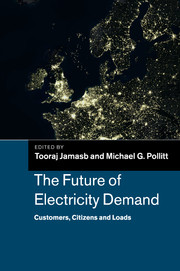Book contents
- Frontmatter
- Contents
- List of Figures
- List of Tables
- List of Boxes
- List of Contributors
- Foreword
- Preface
- Acknowledgements
- Introduction and overview of the chapters
- Part I The economics
- Part II Technology
- 5 Demand-side management and control in buildings
- 6 Smart metering: technology, economics and international experience
- 7 Smart domestic appliances as enabling technology for demand-side integration: modelling, value and drivers
- 8 The scope for and potential impacts of the adoption of electric vehicles in UK surface transport
- Part III Social dimensions
- Part IV Policy and regulation
- Index
- References
8 - The scope for and potential impacts of the adoption of electric vehicles in UK surface transport
from Part II - Technology
Published online by Cambridge University Press: 05 March 2014
- Frontmatter
- Contents
- List of Figures
- List of Tables
- List of Boxes
- List of Contributors
- Foreword
- Preface
- Acknowledgements
- Introduction and overview of the chapters
- Part I The economics
- Part II Technology
- 5 Demand-side management and control in buildings
- 6 Smart metering: technology, economics and international experience
- 7 Smart domestic appliances as enabling technology for demand-side integration: modelling, value and drivers
- 8 The scope for and potential impacts of the adoption of electric vehicles in UK surface transport
- Part III Social dimensions
- Part IV Policy and regulation
- Index
- References
Summary
Transport and energy in the UK
In 2008 transport comprised 35.5 per cent of total UK final energy consumption (by user). The breakdown of this demand by energy source is shown in Table 8.1 (BERR, 2009). Electricity provides only 1.2 per cent of the transport sector's energy demands, although it provides almost half of the energy used by the rail sector. The two most important users of energy are road transport (71.7 per cent) and air transport (21.8 per cent). Domestic shipping comprises only 3 per cent of energy consumed. Overall domestic transport was responsible for 131.4 million tonnes of carbon dioxide in 2007, which corresponds to 24.2 per cent of the national total (DfT, 2009a). While the future demand for aviation remains a significant policy issue for climate change, there appears little prospect of switching propulsion technology in aviation or shipping in the medium term and no further consideration is given to them in this chapter.
Traffic has grown by 13.9 per cent over the period from 1997 to 2007 and is forecast to grow by a further 25 per cent by 2025 (DfT, 2008a). The key drivers of this growth in demand are income, employment, population and travel costs. Table 8.2 shows how the demand for petroleum products has varied across cars, and light and heavy goods vehicles, over the period 1997–2007 alongside the change in kilometres driven. There have been advances in engine efficiency and a shift to diesel cars, which have kept the rise in energy demand at 2.8 per cent, well below the rise in kilometres. There has been a significant increase in vehicle kilometres in recent years in the light goods vehicle sector. Bus and coach travel accounts for only 4.2 per cent of all petroleum products.
- Type
- Chapter
- Information
- The Future of Electricity DemandCustomers, Citizens and Loads, pp. 212 - 228Publisher: Cambridge University PressPrint publication year: 2011



